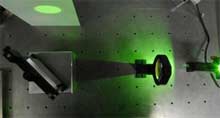Light-emitting diodes save energy. In terms of their light output, however, they have so far been unable to compete with light bulbs. A new, low-priced optical component is set to change that situation: It concentrates the light and directs it precisely to where it is needed.
Light-emitting diodes are unbeatable in terms of energy efficiency. A one-watt LED delivers roughly the same optical output as a hundred-watt light bulb. If a high light output is required, however, the tiny light sources are not the preferred means of illumination. A novel optical component is set to change that situation. It directs the light to the exact spot where it is needed. In the case of a desk lamp, for instance, the light can be concentrated in such a way that only a DIN-A4-sized surface in the middle of the table is brightly lit. The LED evenly illuminates the required area, while everything else stays in the dark.
“A light-emitting diode is a single-point light source that emits light in a large, uncontrolled area,” says Dr. Christian Wenzel, head of department at the Fraunhofer Institute for Production Technology IPT in Aachen. “We use special lenses to direct all of the light to the place where it is needed, thus increasing the efficiency of the LEDs. The spot of light created by the light source does not therefore fade out at the edges, but has a sharply defined edge.”
This channeling of light is based on a free-form system of optics – a plastic lens whose geometry can be shaped in any way desired. “The lenses are cast using an injection-molding technique. The two halves of the tool that serve as a mold have to be aligned with extreme precision just once – they have an accuracy of a few microns, or less than a tenth of the diameter of a hair. Once the tools have been tared, the lens can be manufactured in large batches at low cost,” says Dr. Wenzel. The researchers at the IPT have optimized the entire process chain: from planning and manufacturing the lens systems to checking their accuracy.
“There’s nothing like it anywhere else in Europe,” the expert claims. There is just one challenge that had to be mastered: The plastic, which is inserted into the mold when hot, shrinks as it cools – the finished lenses are therefore slightly smaller than dictated by the mold. The researchers take this effect into account by repeated, gradual improvement – to an accuracy of a few microns. When the lenses are finished, the scientists check them. To do this, they project a pattern of stripes onto the lens. The distortion of the stripes reveals the curvature, inclination and shape of the lens..

